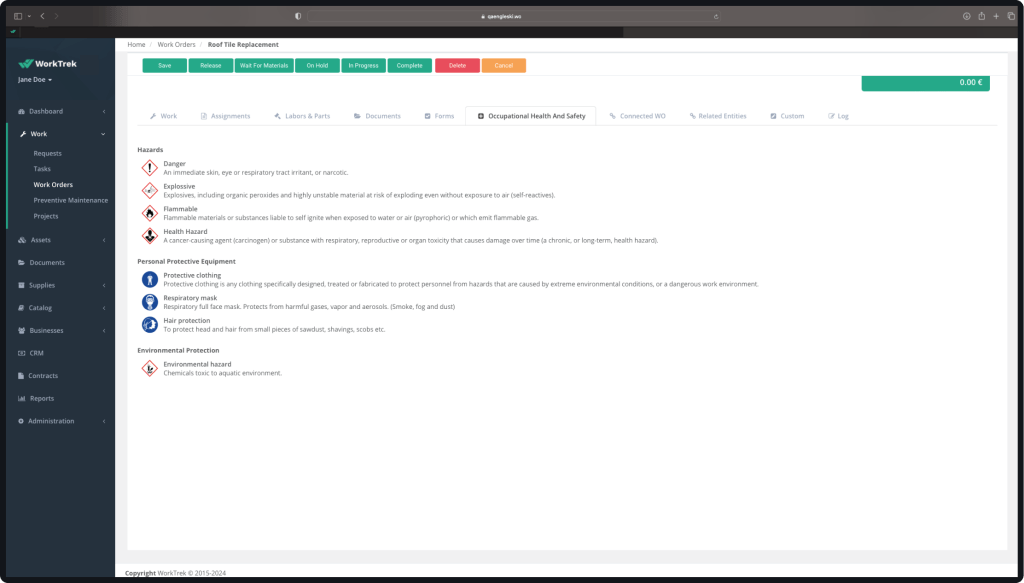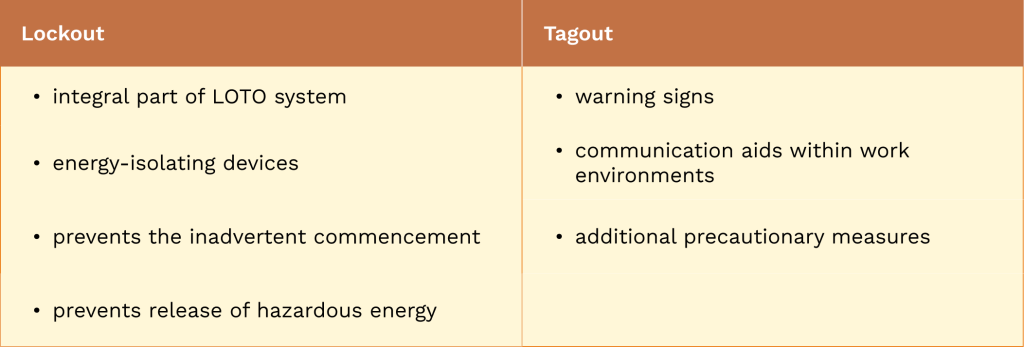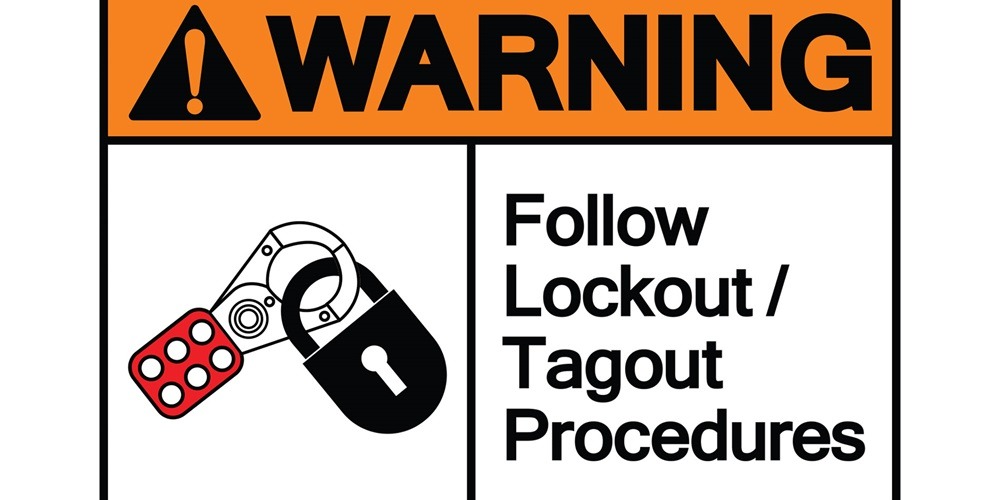Ensuring workplace safety often involves effective Lock Out Tag Out (LOTO) practices. But what exactly is lockout tagout (LOTO), and how can it prevent industrial accidents? This comprehensive look at LOTO procedures delivers vital steps for protecting workers during equipment maintenance.
Key Takeaways
- LOTO is a critical safety procedure to prevent accidental machine startup or energy release. It involves using lockout devices to physically secure energy-isolating devices and tagout devices to serve as warnings.
- An effective energy control program is important for worker safety while maintaining hazardous equipment. It requires the establishment of stringent energy control protocols, the consistent conduct of LOTO reviews, and thorough staff training.
- Regular audits of LOTO practices are essential, and leveraging technology can significantly enhance adherence to safety standards by introducing digital tracking systems and advanced lockout/tagout equipment with integrated sensors.
Understanding Tag Out Lock Out (LOTO) Basics
The LOTO system is a critical safety measure that safeguards workers from unintended releases of hazardous energy while servicing or maintaining equipment and machinery. This ensures that maintenance and servicing activities performed by authorized employees is performed safely.
It utilizes both LOTO devices to secure these power sources. Implementing a comprehensive LOTO program is paramount for minimizing risks such as injuries or even loss of life by ensuring energy isolation while machines are being repaired.

Source: WorkTrek
Mitigating Risks
Locking out isn’t solely about mitigating accident risk. It’s also integral in promoting longevity for machinery and reducing instances where operations must be halted due to unexpected machine startups during service sessions.
Consider what might happen if an individual inadvertently activated equipment under repair—such incidents would severely threaten employee welfare and the hardware’s operational integrity.
In the most simplistic terms, LOTO is the management of hazardous energy. This is crucial in maintaining safety during the repair and maintenance of industrial equipment and machinery.
A Brief History of LOTO Procedures
The LOTO concept has roots in several decades and is largely driven by the need to enhance worker safety in industrial settings.
Before the establishment of formal LOTO procedures, numerous instances of severe injuries and fatalities were caused by the uncontrolled release of hazardous energy during equipment maintenance. As industrial machinery became more complex and powerful, the potential for such accidents increased, leading to a growing recognition of the need for standardized safety protocols.
Industry Adoption
Various industries began developing guidelines and procedures to effectively isolate energy sources and prevent accidental machine activation during repairs.
The evolution of LOTO procedures took a significant leap forward with the intervention of the Occupational Safety and Health Administration (OSHA) in the United States. In 1989, OSHA issued the Control of Hazardous Energy (LOTO) standard, identified as 29 CFR 1910.147, which provided a comprehensive framework for energy control procedures.
This standard was groundbreaking as it mandated specific practices for applying energy-isolating devices, employee training, and periodic inspections. Over the years, these regulations have been refined and updated to address the changing landscape of industrial work environments and technological advancements.
The LOTO standard has reduced workplace injuries and fatalities, proving the effectiveness of well-regulated safety procedures in protecting workers across various sectors.

Source: WorkTrek
Defining LOTO
In the most basic way, LOTO is an essential safety measure that ensures dangerous machinery remains inoperative while undergoing maintenance or repair.
The procedure safeguards employees from potential risks by properly shutting down and securing such equipment. This involves deactivating devices so they cannot release hazardous energy while being serviced or repaired.
LOTO’s principal goal is to avert accidental equipment activation, so it plays a vital role in preventing workplace mishaps and severe harm to staff members.
Lockout Device
Securely locking out and labeling the energy source is imperative to stop hazardous energy from activating machinery unexpectedly, which can lead to devastating outcomes like amputations, broken bones, electrical shocks, or fatalities.
Understanding LOTO allows us to focus on how hazardous energy relates directly to this critical safety process during servicing and repairing dangerous equipment. This enables organizations to improve their safety profile around maintenance or repair work and to implement hazardous energy control procedures.
Energy Isolating Devices in LOTO Procedures
An energy-isolating device is a mechanical device that physically prevents the transmission or release of energy, including, but not limited to, manual disconnect switches, circuit breakers, line valves, and blocks. These devices ensure that equipment is isolated from the energy source and rendered inoperative while maintenance or servicing activities occur.
The Role of Hazardous Energy in LOTO
The process of LOTO is a critical safety measure designed to control the release of hazardous energy and reduce injuries to maintenance personnel. This encompasses numerous forms, such as electrical, mechanical, hydraulic, pneumatic, and chemical energies and thermal sources.
It’s important for employees tasked with performing service or maintenance operations to receive training that will enable them to identify both the nature and scale of the hazardous energy present in their work environment.
Online training resources are available from the Occupational Safety and Health Administration (OSHA) and educational institutions such as Purdue University.
They must learn how it can be effectively isolated or managed. Possessing this knowledge is vital for guaranteeing everyone’s safety during the implementation of LOTO procedures.
Having established an understanding of LOTO, we should explore how lockout devices differ from tagout devices within this context.

Source: ResearchGate
The Distinction Between Lockout Devices and Tagout Devices
Lockout devices are integral components of the LOTO system and are crucial for ensuring the safety of maintenance activities. They attach a lock to energy-isolating devices, which helps prevent the inadvertent commencement or release of hazardous energy during maintenance procedures.
In contrast, tagout involves affixing warning signs that caution workers against using the equipment. This method is less secure than the tangible barrier a lockout device provides.
Lockout devices offer more robust security than tagouts by creating an obstacle to machine activation or releasing potentially hazardous energy by authorized employees.
Tagouts vs Lockout
Tagouts should be considered additional precautionary measures rather than standalone protection methods and are particularly useful in scenarios where implementing a lockout is impracticable. We will delve into understanding these two distinct categories of protective tools.
Purpose of Lockout Devices
Lockout devices are employed to fasten energy-isolating devices throughout the LOTO procedure securely. Securing these devices in a position that guarantees machinery remains de-energized prevents the inadvertent discharge of hazardous energy.
Using a padlock with these lockout devices, which prohibits their unauthorized removal, heightened the safety of equipment under repair. This minimizes potential injuries or fatalities by guaranteeing each service person has a tagged lockout device governed by only one key.
For instance, once employees have completed a LOTO process at an energy isolation point, they secure the lockout device with their key, which is placed inside a lockbox. Subsequently, the employee attaches their padlock to the lockbox.
Role of Tagout Devices
Tagout devices differ from lockout devices in that they act as a clear warning rather than creating a physical barrier. The purpose of using a tagout device is to attach it to an energy-isolating device, conveying the message that controlled equipment should not be used until the tag is removed.
These tools serve as crucial communication aids within work environments. They inform machine operators and other employees impacted by maintenance tasks about active procedures and instruct them to avoid initiating any power sources for relevant machinery, enhancing overall safety standards while repairs or servicing are conducted.
Proper energy control devices and appropriate measures aligned with sound energy control procedures are essential to establishing an effective program.

Source: WorkTrek
Implementing an Effective Energy Control Program
A robust energy control program must be implemented to safeguard employees who perform maintenance and repair tasks. This program should comprise well-documented procedures for controlling hazardous energy, create a seamless process for notifying affected employees, and clearly outline the necessary authorization measures and control methods.
This strategy aims to eliminate any unforeseen activation or commencement of machines and thwart the unwarranted release of stored energy during servicing and upkeep processes.
Energy Control Procedure
The reliance on authorized employees cannot be overstated for successful execution. They are an important cog in an efficient energy control system. Essential components include detailed energy control protocols, employee training initiatives, and periodic LOTO inspections.
Crafting Energy Control Procedures
Organizations must develop and enforce an energy control procedure that effectively isolates and manages hazardous energy during servicing, repair, or maintenance. These protocols should comprehensively cover aspects such as:
- The extent of the applications
- The intent behind these procedures
- Requirements for obtaining authorization
- Rules and directives about energy control
- Methods used for segregating and managing different types of energy sources
- Measures in place to guarantee adherence to said procedures
Executing these hazardous energy control measures is crucial in safeguarding employees while they carry out maintenance operations by regulating potentially dangerous energies.
All equipment within a facility must have specific guidelines for external contractors and internal staff who have been granted permission to conduct work on them. Detailed records elucidate the required actions to prevent unintended machinery activations or releases of hazardous energies.
Training authorized personnel thoroughly cannot be overemphasized—it’s pivotal in ensuring safety standards are always met.
Training Authorized Employees
Employees and contractors with authorization to perform lockout tagout must undergo a training program to teach them the correct application of energy control procedures. This instruction includes lessons on:
- Identifying various sources of energy
- Properly applying lockout devices
- Recognizing, understanding, and assessing hazardous energy risks
- Ensuring authorized personnel confirm their comprehension of the machinery in question and the overarching LOTO protocol by signing off.
A notable advancement in this field is leveraging augmented reality technology to amplify the effectiveness of LOTO instructional sessions. Trainees can receive interactive experience-based learning by using virtual simulations overlayed on equipment. While this type of training is costly, the cost will decrease over time, making it affordable for organizations.
Having established how an effective energy control program operates, we shall now explore procedural steps essential for securely isolating machinery using LOTO techniques.
Steps to Safely Isolate Equipment with LOTO
The LOTO protocol involves a structured sequence of actions, which are:
- Initiating shutdown
- Ensuring separation from power sources
- Effectively securing machines or apparatus
- Affixing, detaching, and relocating LOTO devices as needed
- Making necessary preparations for the process
- Informing all relevant parties involved
- Executing equipment shutdown procedures properly
- Achieving absolute disconnection from energy systems
- Dispersal of any residual energy present in the system.
- Implementation of LOTO measures to prevent reactivation.
- Verification that isolation is complete and effective
These key steps constitute the essential components of a comprehensive LOTO routine.
LOTO Established Protocol
The established protocols should address these specific phases within the LOTO framework.
- Preparing adequately for machine cessation.
- Detaching machinery from every form of an energy isolating device it’s connected with.
- Placing appropriate LOTO safeguards on said devices.
- Neutralizing hazardous stored energies to ensure safety.
- Confirmation through examination that no power sources remain engaged after de-energization has occurred.
Ensuring insulation against any potential power source following the secure placement and tagging process remains an imperative aspect of this procedure.
Let us delve more deeply into each step outlined above.
Preparation and Notification
Before initiating any LOTO process, being prepared and informing all relevant parties is crucial. To proceed, one should:
- Pinpoint the specific equipment, machinery, or procedure that will cease operation.
- Recognize all energy sources linked to said equipment and comprehend the potential dangers.
- Communicate with every individual impacted by the forthcoming tagout procedures regarding their implementation.
When detaching a device from its power supply for secure containment of stored energy, it is essential to utilize standard stopping methods for an orderly shutdown. Following this step involves progressing to affixing LOTO devices appropriately.
Applying LOTO Devices
Securing LOTO devices entails affixing them to energy-isolating mechanisms switched off to control hazardous energy. This is done by directly locking out the power source during machinery maintenance, guaranteeing no electrical current can reach the machine under repair.
After ensuring that all energy sources are adequately isolated and neutralized, employing individual locks and tags for LOTO procedures is important. A normal control trial operation should be conducted to confirm successful disconnection from these energy sources. After testing, always ensure these controls are returned to their off position.
OSHA LOTO standard
OSHA’s LOTO standards protect workers from hazardous energy sources during equipment servicing and maintenance. The LOTO standard, outlined in 29 CFR 1910.147, requires employers to establish energy control programs and procedures to disable machinery and equipment before work begins.
This prevents the unexpected startup or release of stored energy that could lead to serious injuries or fatalities. The LOTO standard covers various hazardous energy sources, including electrical, mechanical, hydraulic, pneumatic, chemical, and thermal.
Employers must use lockout devices, such as locks and chains, to isolate the energy sources and prevent them from being re-energized. If lockout is not feasible, tagout devices like tags and warning signs can be used, but they must provide equivalent protection.
Proper training for authorized employees on LOTO procedures is also mandated to ensure they understand how to control hazardous energy safely. By following these OSHA requirements, employers can significantly reduce the risk of worker injuries and fatalities from unexpected equipment startup or energy release. Compliance with the LOTO standard is estimated to prevent around 120 fatalities and 50,000 injuries yearly.

Source: Electrical Contractor
Strategies for Managing Stored Energy
In LOTO, managing stored energy is essential. This process involves identifying any hazardous energy that might be contained within a machine and dealing with any existing residual energy. Eliminating this leftover or residual energy from machinery is termed ‘Dissipation’.
To confirm the absence of active energy, recommended practices include using a meter to test electrical elements and ensuring that pressure has been adequately released—which can typically be discerned by sound—or through attachment and operation of air tools to confirm depressurization.
When dealing with isolated machines harboring residual power, various methods should be employed, such as reconfiguration, blockage application, and fluid bleeding-out techniques, among others, to neutralize or control it.
Group Lockout Considerations
When multiple workers are involved, group lockout scenarios require increased coordination and communication because the presence of numerous individuals adds complexity. The need for a group lockout arises in situations that include:
- A variety of energy sources
- Multiple teams or employers participating simultaneously
- Successive work shifts requiring continuity
- An essential order of operations to confirm safety measures.
It is vital to appoint a responsible individual to effectively manage the group lockout procedure. This ensures systematic safety by having every worker directly engaged place their locking device onto the collective lockout system.
Navigating LOTO During Emergency Situations
Crises can arise without warning and often lead to confusion. During these times, it is crucial to maintain communication when executing LOTO procedures, especially when departing from normal protocols is necessary.
Periodic LOTO Inspections: Ensuring Continued Safety
Inspections of the LOTO procedures must occur periodically, with a minimum frequency of once per year. These reviews ensure proper adherence to energy control protocols. To carry out this task, an individual designated as the ‘inspector’ who is not actively engaged in using the energy control procedures under review must evaluate a selection of employees as they execute LOTO tasks and confirm their comprehension of their duties.
To automate and simplify this process, you can implement a CMMS system to create the schedules and assign the tasks automatically to technicians.
Employers are charged with quickly resolving any discrepancies or problems uncovered during these evaluations of LOTO practices. This step ensures compliance with established safety benchmarks. With this foundation set, we can focus on particular instances within LOTO scenarios.
Special Cases in LOTO: Exceptions and Exemptions
Sometimes, minor servicing operations essential to the production process might not fall under the LOTO regulations. To be eligible for this exemption for minor servicing, such activities must occur regularly, involve repetition, and be fundamentally necessary for the equipment’s operational use in production.
When the exception for minor servicing is applied, alternative protective measures or tools must be utilized to ensure ongoing safety against hazardous energy. We should also consider ways technological advancements can enhance adherence to LOTO protocols.
Technology and Tools for Streamlined LOTO Compliance
In today’s technologically advanced environment, complex processes are becoming more manageable. When it comes to LOTO, the implementation of software can:
- Enhance oversight and monitoring of adherence to LOTO procedures
- Ensure that equipment which has been powered down cannot be restarted without proper checks and authorization
- Facilitate quick confirmation of whether machinery is properly isolated and authorized for use
Cutting-edge LOTO devices marry electronic padlocks with intelligent sensors, improving the efficiency of the LOTO procedure through sophisticated backend software.
Wireless technologies in LOTO employ radio frequency communication, enabling effective and simultaneous locking and tagging across various systems.
Creating a Culture of Safety with LOTO
The effectiveness of LOTO procedures is deeply rooted in the safety culture prevalent within an organization. The leaders are responsible for ensuring safety and play a crucial role in fostering and maintaining a strong emphasis on LOTO to solidify this culture.
Training
Thorough training and clear communication are vital components that enable proper understanding and execution of LOTO protocols. These protocols are instrumental not only for the successful application but also for adherence to regulatory demands.
Informal mechanisms for reporting issues with LOTO are critical in reinforcing employees’ commitment to safety. They enable them to identify and report inconsistencies, guaranteeing that LOTO processes are uniformly observed.
Summary
The LOTO (Lockout/Tagout) system is essential for safeguarding employees during maintenance and servicing tasks. This article covered everything from grasping the fundamentals of LOTO to executing a successful energy control program and managing emergencies.
Adopting LOTO procedures enables companies to foster a secure and efficient work environment that protects employee health and meets regulatory obligations.
Frequently Asked Questions
What are the differences between lock out and tag out?
Lockout is a safety procedure in which a physical lock is applied to equipment to ensure that energy cannot be released. It is opposed to tagout, which uses a warning label or tag to indicate that machinery should not be operated.
Ensuring the removal of keys from these locks is crucial for maintaining safety.
What is the purpose of the LOTO system?
The LOTO system safeguards workers from injuries and fatalities by eliminating unintended exposure to hazardous energy while maintaining equipment.
What are the steps involved in the LOTO process?
The LOTO procedure encompasses several essential stages to ensure secure maintenance and servicing operations. These stages involve preparing for the shutdown, notifying relevant personnel, executing it, isolating energy sources, dissipating residual energy, applying LOTO devices, and verifying that isolation is complete.
How often should LOTO inspections be conducted?
Inspections of the LOTO procedures should be done at least once yearly to ascertain that they are properly executed and that safety norms continue to be upheld.
Can minor servicing activities be exempt from the LOTO standard?
Minor servicing tasks essential to the production process may be excluded from complying with the Lockout/Tagout standard, provided they are regular, recurring, and fundamentally necessary for operating production equipment.









